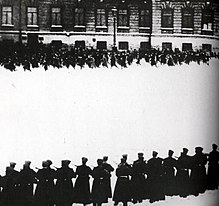Bloody Sunday (1905)
For other incidents referred to by this name, see Bloody Sunday.



Bloody Sunday (Russian: Кровавое воскресенье) was an incident of January 22, 1905 (January 9 by the Julian calendar still in use in Russia at the time) where unarmed, peaceful demonstrators marching to present a petition to Tzar Nicholas II were gunned down by Imperial guards in St. Petersburg. The event was organized by Father Gapon, paid by the Okhranka, the Tsarist secret police and thus considered to be its agent provocateur. Bloody Sunday was a serious blunder on the part of the Okhranka, and an event with grave consequences for the Tsarist regime.
Father George Gapon founded the Assembly of Russian Factory and Plant Workers, an officially sanctioned and police-sponsored organization designed to diverge unrest away from revolutionary activities. In late December, there was a strike at Putilov plant. Sympathy strikes in other parts of the city raised the number of strikers above 80,000. By January 8, the city had no electricity and no newspapers. All public areas were declared closed. Father Gapon organized a peaceful 'workers' procession' to the Winter Palace to deliver a petition to the Tsar that Sunday. He was warned not to act. Troops had been deployed around the Winter Palace and at other key points. An unconcerned Tsar left the city on January 8 for Tsarskoe Selo.
On the appointed Sunday, striking workers and their families gathered at six points in the city. Clutching religious icons and singing hymns, they proceeded towards the Winter Palace without police interference. The army pickets near the palace fired warning shots, and then fired directly into the crowds to disperse them. Gapon was fired upon near the Narva Gate. Around forty people surrounding him were killed, but he was uninjured.
Estimates of the number killed are uncertain. Anti-government sources claimed over 4,000 dead; moderate estimates still average around 1,000 killed or wounded, both from shots and trampled during the panic. As reports spread across the city, there was instant disorder and looting. Gapon's Assembly was closed down that day, and he quickly left Russia. Returning in October, he was assasinated as a police agent by the Combat Organization of the Eser Party.
It is believed that this event sparked the Russian Revolution of 1905.
The petition
The petition, intended to be handed to the Tsar, contained the following demands:
- Freedom of religion and separation of church and state
- Handing the land over to the peasants
- Compulsory education
- Equality before the law
- Progressive taxation system
- Put a stop to land redemption payments (a part of the 1861 Emancipation of the serfs)
- Freedom to form and belong to a union
- Eight hour workday
- Minimum wage
